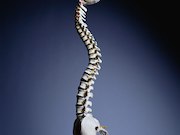No more pain relief than sham procedure for patients with acute osteoporotic vertebral compression fx
THURSDAY, May 10, 2018 (HealthDay News) — For patients with acute osteoporotic vertebral compression fractures, percutaneous vertebroplasty does not result in significantly greater pain relief than a sham procedure at 12 months, according to a study published online May 9 in The BMJ.
Cristina E. Firanescu, from the Elisabeth TweeSteden Hospital in Tilburg, Netherlands, and colleagues conducted a randomized trial in four community hospitals in the Netherlands from 2011 to 2015 involving 180 participants requiring treatment for acute osteoporotic vertebral compression fractures. Patients were randomized to vertebroplasty or a sham procedure. At each pedicle, participants received subcutaneous lidocaine and bupivacaine; the vertebroplasty group also received cementation.
The researchers found that at all follow-up points after the procedure, the mean reduction in visual analogue scale (VAS) score was statistically significant in the vertebroplasty and sham procedure groups compared with baseline. During 12 months of follow-up, there was no significant difference between the groups in the changes in VAS scores. For secondary outcomes, the results were not statistically significant. In both groups, at all time points the use of analgesics decreased significantly, with no significant difference between the groups.
“Percutaneous vertebroplasty did not result in statistically significantly greater pain relief than a sham procedure during 12 months’ follow-up among patients with acute osteoporotic vertebral compression fractures,” the authors write.
One author disclosed financial ties to the medical device and medical technology industries.
Copyright © 2018 HealthDay. All rights reserved.








